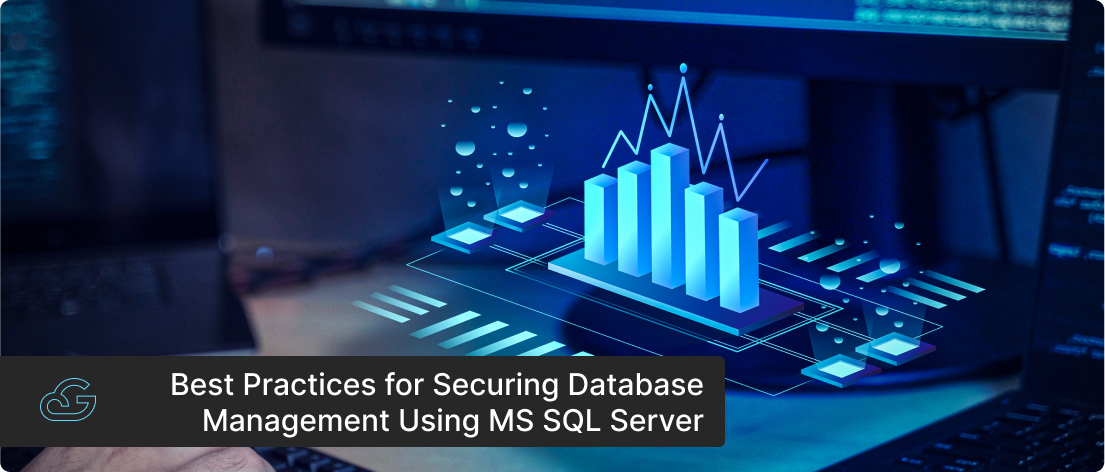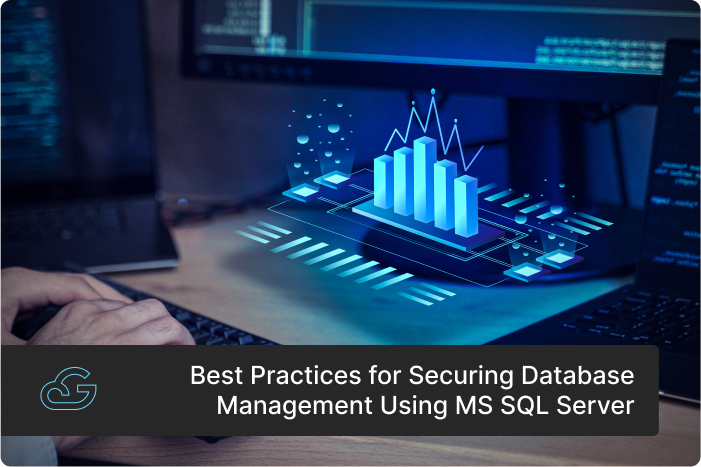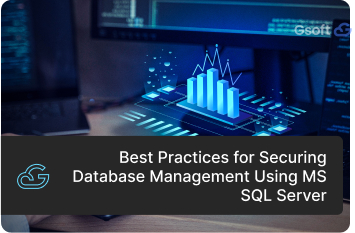Blogs / MS SQL Server
Best Practices for Secure Data Management Using MS SQL Databases
By
Harish K K
Posted: February 26, 2024
• 7 Minutes
MS SQL stands out as one of the most extensively used database management systems, valued for its exceptional performance in data storage, retrieval, and analysis. Its widespread use among data professionals, including data scientists, business intelligence developers, and ETL developers, highlights its significance in the industry.
However, as the prevalence of MS SQL continues to grow, so do security concerns. Cybercriminals are lurking in the shadows to breach MS SQL databases and gain access to the datasets collected by enterprises. By accessing databases, these threat actors or criminals can steal or modify the data stored in them, which will result in major repercussions for enterprises.
This is where database security enters the picture. With robust security measures, companies can outwit these threat actors and ensure maximum protection. Even though these database management systems come with built-in security measures, it is vital that companies or database administrators configure them as per each company’s unique security requirements.
In this blog, we will zoom in on some of the best practices companies can undertake for securing database management using MS SQL Server.
Major MS SQL Database Security Threats
There are many ways in which a threat actor can gain access to a company’s SQL Server. It is important to understand where the vulnerability lies and address it specifically. Let’s look at some of the most common security threats associated with MS SQL Server databases.
-
Connection String Injection Attacks
-
Privilege Escalation
-
SQL Injection Attack
In a connection string injection attack, threat actors exploit vulnerabilities during SQL Server authentication. The authentication mechanism involves connection strings, which typically contain parameters such as server name, database name, and authentication credentials.
Attackers tamper with these connection strings by adding extra characters or modifying existing parameters to execute unauthorized actions on the SQL Server. For example, attackers might alter the authentication credentials to gain unauthorized access to the database, manipulate database queries to extract sensitive data, or execute arbitrary commands on the server.
Privilege escalation occurs when attackers exploit a bug, a flaw in design, or a configuration error to gain elevated access to database functions beyond those originally assigned to them. In an SQL Server environment holding sensitive data, this sort of unauthorized access compromises the confidentiality, integrity, and availability of the data.
An SQL injection attack is similar to connection string injection attacks. But here, the difference is that the attackers add malicious commands to query strings to damage or corrupt the database or steal sensitive information. The attack mechanism involves adding dangerous SQL codes as inputs, which are later executed by the server.
There are numerous other attacks associated with SQL Servers in addition to the ones we have mentioned above. But a common ground that we can identify with each one of these is that all these attacks stem from a lack of security awareness, resulting in a threat actor gaining unauthorized access.
With proactive security measures and practices, enterprises can easily mitigate this while ensuring secure and consistent database performance.
In the next section, we will comprehensively evaluate some of the best practices that companies can use to secure their MS SQL database from attackers.
Best Practices for Secure Data Management Using MS SQL Databases
-
Implement Robust Access Control
-
Use Strong Authentication Mechanisms
-
Leverage Data Encryption Features
-
Adhere to Secure Coding Practices
-
Follow Stringent Monitoring and Auditing Procedures
Implementing strong access control mechanisms is fundamental to enhancing MS SQL database security. Role-Based Access Control (RBAC) and Principle of Least Privilege (PoLP) are two of the most widely used access control models. RBAC, as the name suggests, is employed to assign privileges to users based on their roles within the organization.
With RBAC, administrators define roles—admin, developer, or analyst—and assign appropriate permissions to each role. This simplifies access management and ensures consistency across user groups. To further elevate this, administrators can also combine PoLP and ensure that the users or user groups are granted the minimum level of access necessary to perform their tasks.
By integrating RBAC and PoLP, companies can minimize the threat of unauthorized access. But, companies and database administrators need to keep a close watch on the user roles. They must regularly review and update access permissions and make sure that the permitted level of access aligns with changes in roles or responsibilities.
Using strong and advanced authentication mechanisms is another method that can prevent unauthorized access. Companies and database administrators must enforce strong password policies and mandate users to create complex passwords. Ideally, a strong password must include a combination of uppercase and lowercase letters, numbers, and special characters.
Furthermore, they must also set password expiration and lockout policies to make sure that the passwords are regularly changed. This is vital to avoiding brute-force attacks. Companies can also consider using password strength assessment tools to enforce password complexity requirements effectively.
On top of strong passwords, companies should also consider using multi-factor authentication (MFA) as an extra layer of security in the authentication process. With this, users have to adhere to multiple forms of verification, thereby significantly reducing the risk of unauthorized access, even if attackers manage to obtain the login credentials through phishing or any other means.
Data encryption is a vital aspect of database security, especially if attackers somehow gain access to the SQL Servers. MS SQL provides several encryption techniques, and two of the most predominant ones are Transparent Data Encryption (TDE) and Always Encrypted.
TDE enables the encryption of the entire database, including the data files, log files, and backup files. It operates at the file level, encrypting the data as it is written to the disk and decrypting it when it is read from the disk. This ensures that the data remains encrypted at rest.
Always Encrypted, on the other hand, focuses on encrypting data in transit. That is, it can protect sensitive data within applications. It uses a combination of client-side encryption keys and column encryption keys, delivering a secure mechanism to protect sensitive data within applications. It makes sure that even database administrators or unauthorized users with access to the database cannot view plaintext sensitive data. Only the application with access to the encryption keys can decrypt and view the data.
While these features serve as potent tools for bolstering database security, they are sometimes overlooked by database administrators or companies due to factors such as performance overheads and application compatibility. However, prioritizing the reinforcement of database security is paramount. Therefore, it is imperative for administrators or companies to harness the capabilities offered by SQL Server.
Secure coding practices involve techniques used by developers to write resilient and secure software applications. In MS SQL databases, following secure coding practices prevents SQL injection attacks and helps mitigate other vulnerabilities.
One of the best coding practices that developers must follow is “parameterized queries”. Instead of directly concatenating user inputs into SQL statements, parameterized queries allow the system to treat input values as data rather than executable codes. This prevents attackers from injecting malicious codes, as input values are never interpreted as part of the SQL statement.
Along with parameterized queries, it is vital that developers also conduct rigorous input validation. By inspecting and sanitizing user inputs, they can ensure that the code is free from any malicious content. Common input validation methods involve whitelisting acceptable input formats, blacklisting known malicious patterns, and using data validation libraries or frameworks.
Monitoring and auditing of MS SQL databases are critical for ensuring database security and detecting potential security threats. They provide crucial insights into database activity, discovering suspicious behavior while enabling timely responses to security incidents. Database administrators should establish monitoring procedures to review system logs, event logs, and audit trails regularly. By following these procedures, administrators can track who accessed the database, what queries were executed, and when these actions occurred, etc.
They can also use automated monitoring tools and set up alerting mechanisms, which will help streamline the process by providing real-time alerts for abnormal activities or unauthorized access attempts. Administrators can also try to integrate third-party Intrusion Detection Systems (IDS). These IDS solutions come with advanced features like real-time monitoring, threat detection algorithms, and anomaly detection, which add an extra layer of database security.
Fortify Your MS SQL Server with Gsoft Cloud
Gsoft Cloud offers comprehensive solutions to safeguard your data against evolving security threats. Our managed MS SQL database services are aimed at helping organizations focus on achieving their business objectives while we take care of their database security needs.
Collaborate with us and acquire an MS SQL database that is:
- Highly available
- Extremely secure
- Easily scalable
- Seamlessly compatible
Summary
As more companies embrace digital transformation and a data-centric operational model, it is important that they start shifting their focus to securing databases like MS SQL. With threat actors employing advanced tactics to infiltrate these databases, it is imperative that companies act proactively to curb this threat. With a bit of diligence and care, companies can bolster their database security. Follow the best practices that we have outlined in this blog and ensure complete protection of your data.
Reach out to us at www.gsoftcomm.net today and secure your MS SQL database.


Get Know More About Our Services and Products
Reach to us if you have any queries on any of our products or Services.











